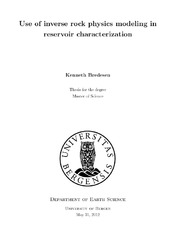| dc.description.abstract | Reservoir characterization based on seismic data demands a robust and reliable method that transforms seismically derived parameters such as elastic moduli, P-velocity, S-velocity or acoustic impedance into parameters delineating lithology and reservoir quality. However, as the number of such desirable reservoir parameters exceeds the number of seismic observables, a straightforward transformation does not exist. Hence, one is restricted to consider an approach by a set of rock physics constraints, which is often associated with a non-linear and undetermined problem with non-unique solutions. Johansen et al. (2011) developed such an approach referred to as inverse rock physics modeling (IRPM) that is based on the estimation strategy of Johansen et al. (2004). There exists numerous rock physics models to cover the large span of di erent natural born rocks. As all these models simplify inherent complex rocks to predict the seismic response, their quantitative accuracy is debatable. Moreover, several reservoir parameters for these models have many elements of uncertainty attached, and it can be challenging to assign them proper values, e.g. the porosity of sediments in a reservoir at the stage of deposition. Despite these problems, the rock physics models have proved to yield constraint data that lie within a manageable proximity to real seismic data. The IRPM approach takes advantage of this fact and may serve as a tool for interpretation of lithology and evaluation of reservoir quality. However, users of the IRPM approach must aim their attention to recognize relevant uncertainties, pitfalls and limitations to reduce misinterpretation risks. This study considers a set of rock physics constraints where particular reservoir parameters have been perturbed to mimic uncertainty. From considering synthetic data, it was found that uncertainties in the reservoir parameters considered had a signi cant in uence on the corresponding inverse solutions. In reservoir monitoring the supervision of temporal uid pressure and saturation alterations during production is key information to achieve optimized oil recovery. The IRPM approach is exible to incorporate reservoir parameters that are of interest in reservoir monitoring. This study applies IRPM on real data from Glitne, North Sea, to predict pore pressure, saturation and porosity after a period of production. However, due to absence of repeated observational data from Glitne, a synthetic hybrid model was used to simulate production e ects on the initial Glitne data. The results obtained showed little variation in the porosity solutions, a wide range of possible saturation solutions and pore pressure solutions that were cumbersome to constrain due to its insensitivity in the Glitne rock physics model. The solutions emphasize limited applications of IRPM to constrain particular reservoir properties that are highly insensitive in certain rock physics models. | en_US |
